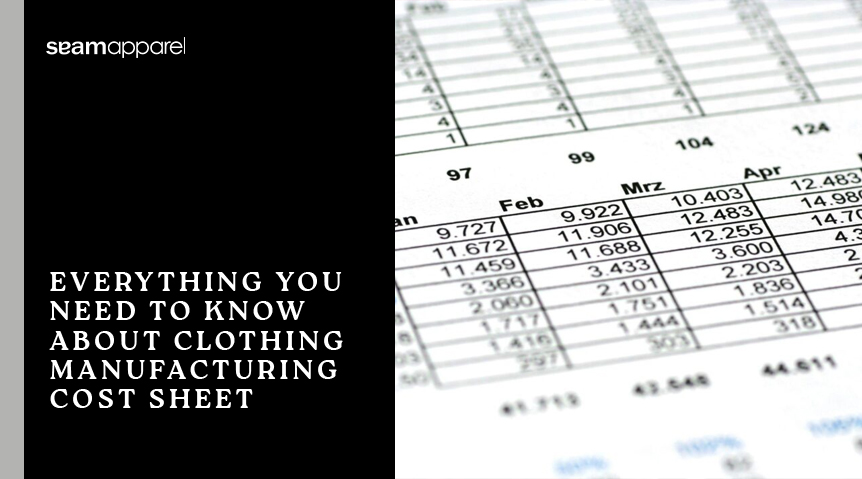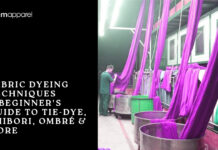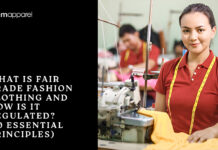Working at a fashion company has several benefits, including creativity, glamour, and excitement. Budgeting, however, is another factor that is equally crucial to take into account. Many different persons are involved in the creation of a garment, and various interests are at stake.
Although you desire a high-quality final product that is reasonably priced, you also need to make a profit to maintain the brand and fund the coming season. It is complicated, which is why it sounds that way. But don’t worry; we’ve got you covered. This is the definitive guide to pricing and costing for starting a clothing line.
Costing And Pricing Techniques For Clothing


The three cost accounting techniques for identifying, measuring, and allocating costs are listed below.
Direct Costing
This is the most basic costing method in manufacturing, also known as variable costing that is applied in the apparel industry. How to find the total manufacturing cost, the product cost, or the cost of goods, is calculated using this technique of cost by adding the total variable costs for labor and materials.
In addition, all fixed manufacturing costs, marketing, product development, general, and administrative expenses are allocated through gross margin as either a fixed cost per clothing or as a target gross margin%. Finding clothing manufacturers who create basic clothes with little variation in labor, product development, and marketing costs, such as basic jeans, t-shirts, classic suits, etc., is very successful with this type of costing strategy.
Integration Costing
In addition to allocating variable manufacturing expenses to each unit of production, absorption costing also allocates fixed manufacturing overheads. It is additionally known as the entire cost method. As the name implies, all clothing sampling production costs—both constant and variable—are absorbed into the cost of the goods, which is utilized to determine the cost values.
This method of costing is unique in that it considers how variable and fixed manufacturing overheads affect each style produced about one another. The benefit of this is that manufacturing overhead expenses are distributed more fairly among the many styles so that low direct labor products do not have to bear the weight of high direct labor products’ overhead costs.
Costing Based On Activity


It is regarded as both the most accurate and challenging costing system. It operates under the tenet that each cost-generating activity is categorized and valued independently. Based on how the sorting activities are used by the clothing, the activities are assigned to the clothing. These include things like administration of materials, engineering, operator training, planning of production, quality control, advertising, and market research.
The challenge with this technique is coming up with a standard costing system that can track costs and assign them to particular items. To obtain correct costing data, it is also crucial to relate the difference between the activity cost and the actual usage of that cost by a certain garment design or category.
Thus, activity-based costing focuses on the activity as the foundation for cost allocation. The department managers now must make the best use of these efforts to directly benefit product categories or styles to justify their expenses.
The Factors Of Garment Costing
Cost of apparel factors: Continuing with the other features the product’s costing must be completed by the production merchandiser as well. The costing is completed while taking into account the fashion price point of the various raw materials, the operating expenses of the business, the level of competition, and the anticipated financial success of the enterprise. The buyers’ cost expectations must also be taken into consideration.
The following factors determine a garment’s price:
- Charges for Fabric Trims: Cut, Make, and Trim
- Services that add value include printing, embroidery, washing, and appliqué.
- Evaluation of the clothing
- Quality
- Cost of logistics and transportation
- Gain for the manufacturing company.
All of these garment and CMT cost components are based on particular factors, which have a significant impact on the cost parameters above. These variables are quite dynamic and constantly change, thus they are crucial when the production fabric calculator for clothing cost.
Unit of Measurement, Minimum Order Quantity, and Incoterms agreed upon by the raw material supplier and apparel manufacturer, Order Quantity, etc. are the main factors that determine garment cost.
What Is A Cost Sheet In The Garment Industry?


The overall cost of a product or process can be calculated using a costing sheet, which is a statement or format where all costs are entered systematically. The working sheet or worksheet is another name for it. The relevance of the garment costing sheet in the manufacturing of ready-to-wear clothing is excessive.
How Do You Create A Cost Sheet In The Garment Industry?
The perfect cost sheet should be straightforward while still being comprehensive enough to provide all the necessary details regarding the garment you are creating. With the aid of garment technology, you can make a tidy, well-organized cost sheet that tracks every expense and serves as both a record and a reference tool.
Many businesses still use Excel for their costing procedures such as embroidery pricing spreadsheets. They are unclear, challenging to read, and prone to calculating mistakes.
Major Elements of Costing Sheets For Clothes
There are four main parts to a costing or cost sheet. The following are those:
Initial cost, Work-related factory costs, Office costs, and Total costs.
Following are explanations for all the aforementioned points:
-
Prime price
Direct materials, direct labor, and direct expenses make up the prime cost. Basic cost, flat cost, and first cost are other names for it.
Prime cost is equal to the sum of the direct costs (D.M., D.B., and direct expenses) (D.E)
-
Manufacturing Or Labor Costs
Prime cost and works or factory overhead make up factory cost or work cost. It is sometimes referred to as the cost of producing the clothing manufacturing cost estimation.
Prime cost plus factory overheads equal factory cost.
-
Office expenses
A manufacturing or work expense, as well as office and administrative overheads, make up office costs. The terms “office expense” and “apparel manufacturing” are interchangeable.
Office cost is equal to factory cost or work cost plus administrative and office overheads.
-
Total expense
The total cost is calculated by adding selling and distribution expenses and the definition of the cost of production of the sold commodities, which are clothes. It also goes by the name “cost of sales.”
Total cost equals selling and distribution overheads plus office costs.
When revising product prices while they are being developed, this is frequently especially inconvenient. As you are aware, things are always changing, so having to manually reintroduce everything would take a lot of effort and be quite prone to error.
What Is The Cost Of Making Garments?


CM cost, which stands for “Cost of Making,” typically refers to the cost of each garment’s sewing line. However, you may also figure out how much does it cost to manufacture clothes?
An essential component of clothing merchandising is calculating the cost of manufacture (CM) for any individual garment item. The correct method of fabric costing calculation should be known by every merchandiser of clothing. Otherwise, a factory can suffer a significant loss. Today I’ll provide a simple way for determining the cost of creating (CM) for every article of clothing due to its significance in the clothing retailing industry.
How much it costs to make a sweatshirt: The most time-consuming type of apparel to make is technically a Starting a clothing business sweatshirt. It frequently needs a specific type of interfacing to maintain its shape because it is entirely lined. For example, you should use a woven fusible hair canvas if you want to achieve a customized, more structured look. A woven non-fusible mid-weight interfacing can be your best option if you’re striving for a softer appearance.
How Should the Cost of Making (CM) Clothes Be Calculated?
A garment merchandiser should make sure of the following things before determining the cost of manufacture (CM) for any clothing items:
- Total monthly costs for running the plant include rent, utilities, commercial costs, transportation, salaries for workers and personnel, etc.
- A comprehensive count of the factory’s machinery.
- The total number of machines needed to finish a task.
- Intended output per hour using the current setup (excluding alter and reject).
- The monthly total of working days.
- Total daily work hours.
- The cost of creating actual garments may now be simply calculated by a merchandiser of clothing by using the formula below.
Cost of production (CM) per piece,
Factory total expenditure monthly * Total no of machines required to complete an item
DIVIDED BY
Total machine * Total working day/cost of clothes per month * Total working hours/day * Targeted production/hour
What Is The Profit Margin In Garment Manufacturing?


A fashion-forward entrepreneur has little to fear from taking the big leap into owning and running a retail clothing business if she has a genuine interest in clothing, enough initial funds, and a keen business sense. Retail clothing businesses, like all businesses, are focused on making money. One of the most crucial financial computations required to ascertain how much profit a company makes is the profit margin.
Pricing tactics can be a crucial strategy to increase sales when several apparel firms are vying for the same consumers’ dollars—as long as profit margins are high enough to demonstrate viability.
Profit Margins:
The amount the business keeps after deducting costs stated as a share of total sales is the profit margin on clothing. Sales minus costs = profits, and profits divided by sales equal profit margin, according to a straightforward equation. For instance, if you purchase a shirt for $70 and sell it for $100, your profit is $30 ($100 – $70). $30 divided by $100, or 30%, is the profit margin.
Markup vs. Profit Margin
Markups and profit margins are frequently misunderstood. They are similar in that they represent a sum of money that is greater than the cost of the product, but the profit margin clothing manufacturer is based on sales while the markup is based on price. If a pair of pants costs $20 and is marked up to $40, the difference, or 20%, is a 100% markup. The profit margin is 50% if you sell that pair of pants for that cost.
Costs: Fixed and Variable
The cost of producing an item is ultimately what determines the profit margin. No matter how many goods you produce, fixed costs such as rent, utilities, and some salaried employees remain constant. Costs that vary according to how many goods you produce, like materials and supplies, are known as variable costs. Cutting variable costs, which have an impact on sales at all levels, is often advised to raise profit margins without raising the sale price.
Clothing Industry Profit Margins
Industry researchers claim that profit margins for retail clothing typically range from 4 to 13 percent. When compared to the cost of goods sold, another name for variable costs, markups can appear to be high. When these expenses are taken into account, the profit the clothing firm makes is substantially lower, and clothes merchants need to sell a large number of items to continue in business.
FAQs
What Basic Costing Techniques Are There?
The main costing methods that are available are process costing, job costing, direct costing, and throughput costing. Each of these approaches can be used in various production and decision-making situations.
What Is The Costing Method ABC?
ABC is a technique for allocating overhead and indirect costs, such as salaries and utilities, to goods and services. The ABC system of cost accounting is built around activities, which are defined as any occasion, project, or task with a clear objective.
Final Words
A key method for reducing costs, preventing waste, and maximizing the use of raw materials and resources is garment or apparel pricing. Developing a greater sense of style for customers and cost of manufacturing clothing process more transparent can both be accomplished by employing the proper way of garment costing.






